The modern streetcar in Tucson, Arizona is not like any of the ones you have seen in old Hollywood movies. Remove any image of Marlon Brandon shouting “Stella” from your mind when thinking about this state-of-the-art streetcar.
While Tucson’s streetcar may not look like ones from A Streetcar Named Desire, there were a lot of big desires and hopes riding on it. Primarily the desire that it will help spur economic development and revitalize the city’s downtown.
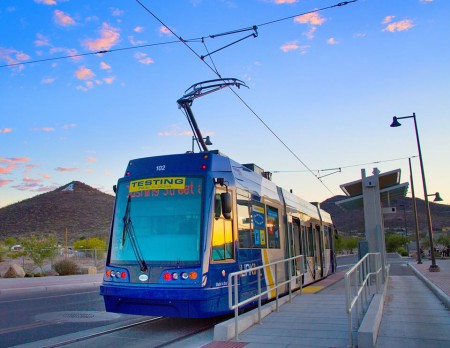
Credit: City of Tucson Department of Transportation
Just a few years ago, Tucson watched Phoenix, it’s big neighbor to the north, successfully build out a new lightrail system. At this time, mass transit in the second largest city in the country’s fastest growing state (according to the U.S. Census Bureau’s latest estimates) was only a plan on paper, a vision of the City of Tucson’s Department of Transportation and many residents.
The first real chance for the City of Tucson to install a mass transit system came when the project was added to the $2.1 billion, 20-year Regional Transportation Authority Plan approved by voters in 2006. Inclusion in the plan provided public support and the largest portion of funding, $87.7 million, for a modern streetcar. An additional $63 million in funds came from a Transportation Investment Generating Economic Recovery (TIGER) grant provided to the City of Tucson by the U.S. Department of Transportation in 2010. This helped close the funding gap and increase momentum on the project.
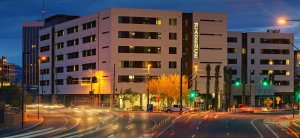
The Cadence, new University of Arizona student housing in downtown Tucson. (Credit: Ankrom Moisan)
Throughout it’s construction phase, Tucson watched as the modern streetcar turned desires of revitalizing the city’s funky and vintage downtown area into a reality. Developers and business owners jumped at the chance to be part of transit-oriented development and set up shop along the route, and they are still jumping. Tucson’s downtown has gained hundreds of millions of dollars in public and private investment thanks to the installation of the streetcar. Bustling, hip new restaurants, bistros, and bars now line the route, and the University of Arizona worked with developers to build new student housing downtown making it easy for students to take the streetcar to and from campus.
This past July, Sun Link – the rebranded Tucson Streetcar, began operations, an effort 30-years in the making. Today, Sun Link runs seven days a week along the 23-stop, four-mile route that connect’s the University of Arizona, downtown business districts, entertainment venues, and the convention center. Members of the community came out in mass to celebrate the grand opening of Sun Link. The little streetcar that could saw 17,000 riders its first day of operations during a free ride promotion. A little more than two months into its operations and there are murmurs of a new desire to expand the route. Sun Link is on the right track to become an icon in Tucson’s community landscape.
Today, we continue our series on BIG projects hearing from Shellie Ginn, a Transportation Administrator for the City of Tucson’s Department of Transportation and the project manager and champion who worked on the Sun Link for the past decade. We welcome her insights.
– – –
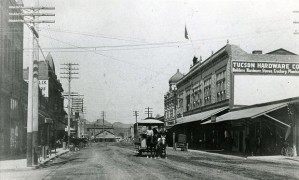
Looking west down Congress Street in Tucson, AZ in the 1890’s.
(Credit: Tucson Historical Society)
Sun Link is a first-of-its kind transportation option for Tucson. Where did the idea for this modern streetcar originate?
First, let me remind you that we once had historic trollies running through Tucson in the late 1800’s and early 1900’s. The concept of the modern streetcar was one of several options considered during an Alternatives Analysis started in 2004. The goal was to connect activity centers in the central/downtown Tucson area and provide a vehicle for economic development. Ultimately, the streetcar was selected as the mode of transportation to meet those goals.
Why was a fixed-guided electric rail system chosen over other alternative transportation systems such as a lightrail?
The streetcar was selected due to the greater economic development potential it offered to this area. Other cities such as Portland, Oregon and Seattle, Washington had seen a revitalization of their downtowns due to this type of transit system. We had similar activity centers and were certain we could see the same results.
The Sun Link route connects the University of Arizona, business districts, and the convention center. What other alternative routes were considered and why was its current route chosen?
The majority of the current route was in all of the alternatives considered. The areas where we had different alignments were around the University of Arizona (around vs. through?) and also how long the system would be. We looked at multiple alignments that included one on 6th Street versus 2nd Street and a longer alignment that traveled up Campbell Avenue to Grant Road. The current route was selected due to its use of roadways that were more pedestrian focused and also directly connected five districts (Mercado District, Downtown, 4th Avenue District, Main Gate District and the University of Arizona). Also, traversing through the University of Arizona campus had the greatest ridership potential.
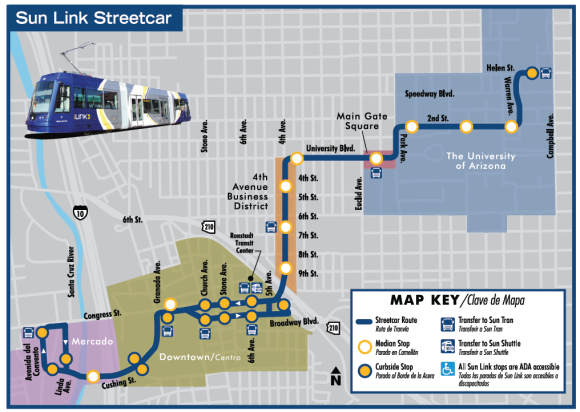
Sun Link Route Map
(Credit: City of Tucson Department of Transportation)
What type of community involvement was done? What aspects of the project did the community help define?
The community was involved from the beginning of the project. We developed a Citizens Liaison Group (CLG) which was made up of representatives from the neighborhoods along the alignment, business association groups in each of the districts being considered for the alignment and special interest groups such as the Tucson/Pima County Bicycle Advisory Committee and the Commission on Disability Issues. Education facilities were represented as well. This group helped review multiple technologies and alignments ultimately selecting the modern streetcar as the preferred technology and the current alignment as the preferred route.
Since Sun Link was new to the community, what type of public education efforts were undertaken?
Public Education and outreach were critical to this project and was included throughout the entire ten years this project has been in development, design, construction, testing and finally, operations. Reaching out to the public and including them in the decision making process led to a transit system that is exceeding its ridership goals and promoting economic development along the entire four-mile line. Our outreach included many presentations to stakeholders along the alignment and throughout the Tucson community, public open houses, and briefings to various leadership in the City, County, State and Federal government. Public outreach and education will be ongoing as a new group of students arrive on the University of Arizona campus each Fall Semester.
Sun Link has been credited with helping to revitalize Tucson’s downtown. How has it done this and what are some of the economic development benefits it has brought to the community?
The Tucson Streetcar has been instrumental in the location of several student housing developments along the four mile line. There are over 3,000 units along the line. There are over 50 new restaurants, bars and cafes that have opened up along the four mile line. Over $800 million of public and private investment has been made with an estimate of over 1,500 long term regional jobs created as a result of the streetcar.
An estimated 3,500 people rode Sun Link on its first paid day of operations. Has this ridership sustained? Who are the main people riding on the weekdays versus weekends?
The average weekday ridership is approximately 5,200 per day and the average weekend ridership is 2,700 (with Saturdays in the 5,000 range). There is a mix of ridership to include students, office workers, people riding in the evenings for dinner and entertainment and neighborhoods taking advantage of the streetcar to ride along the four miles.
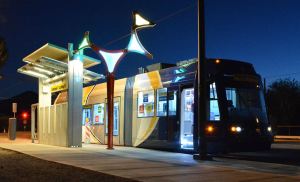
“Wandering Stars” by artists Joe O’Connell and Blessing Hancock at the Granada Ave/Cushing Street stop.
(Credit: City of Tucson Department of Transportation)
One unique aspect of the Sun Link route are the different art pieces incorporated at each of its 23 stops and its Operations and Maintenance facility. How were the artists and their pieces chosen?
The art was selected through the Tucson Pima Arts Council (TPAC). Eight stops were identified along the alignment (two per mile) and a simple stop concept and the maintenance facility were added as potential art locations as well. TPAC oversaw a public selection process and the artists were selected based on their artistic concepts through a committee.
What are the opportunities to expand the Sun Link route in the future? What would it take to do so?
Potential extensions are identified in the Pima Association of Governments High Capacity Transit Study from 2009. The next step is to start studying the potential routes and determine what funding will be used.
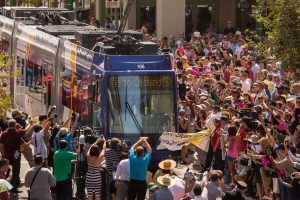
The Sun Link breaking the banner at it’s grand opening celebration on July 25, 2014.
(Credit: City of Tucson Department of Transportation)
You served as the City of Tucson’s Project Manager for Sun Link for 10 years and guided it from conception to implementation. What was your favorite part of this project?
Over the last ten years, I was able to watch a concept become a reality and see the direct benefits of this type of system in the five districts along the streetcar alignment. My favorite part was the Grand Opening and seeing all of these people wait in long lines with smiles on their faces. It has been such a pleasure to work on a project of this stature.
– – –
For more information on Sun Link visit www.sunlinkstreetcar.com, like it on Facebook, or follow it on Twitter.

Recent Comments